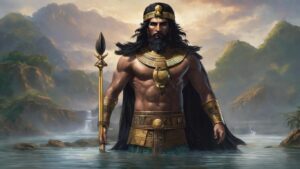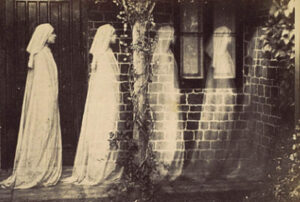Table of Contents
Writers and artists draw inspiration from Baal and related mythologies, infusing their creations with echoes of ancient mysticism. Poets intricately weave references to Baal, and symbols like bull horns or lightning bolts, reminiscent of Baal’s legacy, punctuate contemporary art, evoking profound symbolism.
In political and social discourse, the metaphorical use of “Baal” abounds, symbolizing oppressive forces. Leaders, under critical scrutiny, morph into modern-day “Baals,” embodying perceived tyranny. This symbolism, deeply rooted in history, serves as a stark reminder of the enduring relevance of ancient myths.
Symbols linked to Baal, such as bull horns or lightning bolts, transcend time, finding application in modern branding and logos, resonating in the visual language of power. Individuals adopt Baal-inspired symbols like lightning bolts in tattoos or body art to express personal convictions.
In academia, Baal becomes a focal point in courses on mythology, archaeology, and ancient history. Educators use Baal as a lens for students to explore cultural and religious diversity, enriching understanding of ancient civilizations.
In popular culture, Baal’s influence permeates fictional works across movies, television, and video games. Characters and elements inspired by the deity engage audiences, exploring themes of nature, power, and the supernatural. Baal’s impact extends beyond history books into modern narratives.
Archaeological treasures linked to Baal worship, displayed in museum exhibits, tell tales of ancient civilizations. Artifacts and inscriptions offer glimpses into cultural practices, contributing to public awareness. Documentaries and media reports amplify the significance of Baal, illuminating the historical tapestry of ancient civilizations.
In spiritual movements, echoes of Baal resonate as modern pagan communities incorporate elements into their practices. Rituals and ceremonies draw inspiration from the symbolism associated with the ancient deity, reflecting an ongoing dialogue between past and present in spiritual seekers’ exploration of ancient traditions.
Fast Facts:
Pronunciation: “Baal” can indeed be pronounced as “Bail” or “Bal,” and both pronunciations are commonly used.
Origin: The worship of Baal has its origins in the ancient cultures of Canaan and Phoenicia, where different deities with the title “Baal” were venerated.
Role: Baal was associated with various aspects, including fertility, the sun, and storms. Different manifestations of Baal were worshipped for their perceived influence over agricultural abundance, weather phenomena, and the cycles of nature.
Symbols: Lightning bolts and bull horns are indeed among the symbols associated with Baal. The lightning bolt represents the storm aspect of Baal, while bull imagery is often linked to fertility and strength.
Parents: The parentage of Baal can vary in different mythological traditions. While El is considered a chief god and sometimes identified as a father figure in certain contexts, it’s worth noting that the relationship between El and Baal can differ in various myths. The association of Asherah as a mother figure for Baal is not consistent across all traditions.
Who Is Baal?

The term “Baal” holds historical and religious significance, referring to different entities based on context.
In ancient Semitic religions, “Baal” served as a title meaning “lord” or “master.” Regional deities, each associated with nature or fertility, held the title. Baal worship thrived in the ancient Near East, embraced by the Canaanites and Phoenicians.
In the Bible, especially the Old Testament, “Baal” designates false gods or idols worshipped by the Israelites. Prophets in the Hebrew Bible vehemently denounced the worship of Baal and other foreign gods.
Within mythological contexts, the term “Baal” establishes connections with distinct deities, such as Hadad, the revered storm and rain god within the Canaanite and Phoenician pantheons. Hadad, frequently synonymous with the title Baal, occupies a prominent role in these narratives.
Expanding the scope, the term “Baal” assumes significance in literature and culture, serving as a symbol for a commanding or influential figure. This association, however, often carries negative or tyrannical connotations.
The interpretation of “Baal” varies across cultures, religions, and historical periods. Understanding differs between ancient religious contexts, biblical literature, and contemporary usage.
Baal as a Fertility God
Baal’s common association with fertility, particularly in the realm of agricultural abundance, manifested through rituals and ceremonies aimed at ensuring prosperous harvests and overall land fertility.
Transitioning to the connection with the Earth, while Baal was intricately linked to fertility, his direct association with the earth was not as explicit as his ties to fertility and storms. The earth element often found association with other deities within various ancient pantheons.
Considering the export of beliefs to Egypt, worship of deities sometimes traversed ancient cultures through cultural exchanges and interactions. However, the direct export of Baal to Egypt lacks well-documented evidence. It’s crucial to acknowledge that diverse cultures maintained distinct pantheons and deities.
Shifting the focus to Baal’s association with storms, in certain mythological traditions, Baal indeed held a significant role as a storm and rain deity. The narrative surrounding Baal’s control over the weather, particularly storms, played a pivotal role in the Canaanite and Phoenician pantheons.
Origin
The origin of the term “Baal” can be traced to ancient Semitic languages. Additionally, “Baal” is a Northwest Semitic word signifying “lord” or “master.” This title was applied to various deities in the ancient Near East, carrying religious and cultural significance in the region’s societies.
Moreover, the worship of Baal was prevalent among the Canaanites, Phoenicians, and other ancient Semitic cultures. In different regions, specific deities with the title Baal were associated with natural elements, fertility, and weather phenomena.
Notably, the word “Baal” derives from the Northwest Semitic root bʕl, indicating ownership or mastery in linguistic origin. This root is also present in other Semitic languages such as Akkadian and Ugaritic.
In ancient texts, including the Bible, there is frequent mention of the worship of Baal and related deities. This worship is often linked to the condemnation of idolatry. Furthermore, over time, literature and culture have broadened the use of “Baal” to refer to powerful or oppressive figures. The term has left a lasting imprint on the historical and religious narrative of the ancient Near East.
Family
Various deities in ancient Near Eastern mythology linked themselves to the term “Baal,” with each deity possessing distinct characteristics and roles within their respective cultures. Transitioning to specific examples, Hadad, also known as Baal-Hadad, emerges as a prominent figure—a storm and rain god venerated in the ancient Near East. His mythological narratives frequently revolved around battles with other gods, symbolically representing the changing seasons and the cyclic nature of the environment. Hadad’s influence extended widely, encompassing regions like Canaan and Mesopotamia.
Moving on to Baal-Hamon, a Phoenician god associated with fertility and agriculture, we find another facet of the diverse “Baal” mythology. Worshipped significantly in Carthage, Baal-Hamon was often portrayed adorned with symbols of abundance, such as a cornucopia.
Shifting focus to Ba’al Zebub, a Philistine deity mentioned in the Bible, we encounter a different dimension. In some traditions, Ba’al Zebub was perceived as a god of healing or a fly god. The New Testament further references the name in a derogatory manner, associating it with demonic entities.
It’s crucial to recognize that the concept of “Baal” and the associated deities underwent variations across different cultures and regions, leading to a tapestry of diverse mythologies and interpretations. While family connections among these deities do not align with human familial structures, they reflect the intricate diversity of titles and roles attributed to gods carrying the designation “Baal” in various ancient mythologies.
Religious Influence

The term “Baal” and associated deities have had a significant religious influence, particularly in the ancient Near East. Here are some aspects of this influence:
Canaanite and Phoenician Religion: Baal was a central figure in the religious beliefs of the Canaanites and Phoenicians. These cultures attributed various aspects of nature, fertility, and weather to different deities with the title “Baal.” The worship of Baal involved rituals, sacrifices, and ceremonies aimed at seeking the favor of these gods for agricultural prosperity and general well-being.
Biblical Context: The Hebrew Bible (Old Testament) frequently condemns the worship of Baal. Prophets like Elijah and Jeremiah vehemently oppose Baal worship, advocating exclusive devotion to the God of Israel. Narratives, such as the showdown on Mount Carmel (1 Kings 18), depict the conflict between Baal’s followers and Israelite God’s adherents.
Syncretism and Adaptation: As societies and cultures interacted in the ancient world, there was a degree of syncretism, where the worship of Baal and other deities influenced and blended with the religious practices of neighboring peoples. This blending could lead to the incorporation of certain aspects of Baal worship into the belief systems of other cultures.
Literary and Cultural Impact: The imagery and symbolism associated with Baal have left a lasting impact on literature and culture. The characterization of Baal as a powerful deity, often associated with natural forces, has influenced artistic and literary representations in various periods and regions.
Archaeological Discoveries: Archaeological excavations in the ancient Near East have uncovered artifacts and inscriptions related to the worship of Baal, providing valuable insights into the religious practices of these ancient cultures.
Modern Influence
Writers and artists draw inspiration from Baal and related mythologies, infusing their creations with echoes of ancient mysticism. Poets intricately weave references to Baal, and symbols like bull horns or lightning bolts, reminiscent of Baal’s legacy, punctuate contemporary art, evoking profound symbolism.
In political and social discourse, the metaphorical use of “Baal” abounds, symbolizing oppressive forces. Leaders, under critical scrutiny, morph into modern-day “Baals,” embodying perceived tyranny. This symbolism, deeply rooted in history, serves as a stark reminder of the enduring relevance of ancient myths.
Symbols linked to Baal, such as bull horns or lightning bolts, transcend time, finding application in modern branding and logos, resonating in the visual language of power. Individuals adopt Baal-inspired symbols like lightning bolts in tattoos or body art to express personal convictions.
In academia, Baal becomes a focal point in courses on mythology, archaeology, and ancient history. Educators use Baal as a lens for students to explore cultural and religious diversity, enriching understanding of ancient civilizations.
In popular culture, Baal’s influence permeates fictional works across movies, television, and video games. Characters and elements inspired by the deity engage audiences, exploring themes of nature, power, and the supernatural. Baal’s impact extends beyond history books into modern narratives.
Archaeological treasures linked to Baal worship, displayed in museum exhibits, tell tales of ancient civilizations. Artifacts and inscriptions offer glimpses into cultural practices, contributing to public awareness. Documentaries and media reports amplify the significance of Baal, illuminating the historical tapestry of ancient civilizations.
In spiritual movements, echoes of Baal resonate as modern pagan communities incorporate elements into their practices. Rituals and ceremonies draw inspiration from the symbolism associated with the ancient deity, reflecting an ongoing dialogue between past and present in spiritual seekers’ exploration of ancient traditions.
Baal FAQ
Who is Baal?
Baal refers to a title or honorific used for various deities in ancient Semitic religions, particularly in the Canaanite and Phoenician cultures. Different regions had their own specific deities with the title "Baal," often associated with nature, fertility, and weather.
Who was Baal in the Bible?
In the Bible, particularly in the Old Testament, "Baal" is often used to refer to false gods or idols worshipped by the Israelites. The prophets of the Hebrew Bible condemned the worship of Baal, emphasizing the exclusive worship of the God of Israel.
Who is Baal in the Quran?
Baal is not specifically mentioned in the Quran. Islamic theology focuses on the oneness of Allah, and the Quran primarily addresses monotheistic principles.
How to pronounce Baal?
"Baal" can be pronounced as "Bail" or "Bal," and both pronunciations are commonly used.
What does Baal mean?
"Baal" is a title or honorific that means "lord" or "master" in ancient Semitic languages.
Why was Baal worship so popular?
Baal worship was popular in the ancient Near East because it was associated with agricultural fertility, rain, and prosperity. People believed that honoring Baal would bring about bountiful harvests and overall well-being.
Who worshipped Baal in the Bible?
In the Bible, particularly in the Old Testament, some Israelites turned to the worship of Baal and other foreign gods, drawing the condemnation of prophets.
When does Baal come out?
The context of "Baal coming out" depends on the specific reference. In historical and mythological contexts, rituals and festivals associated with Baal worship often involved processions and ceremonies.
What is Baal worship?
Baal worship involved rituals, sacrifices, and ceremonies dedicated to various deities with the title Baal. Practices varied across cultures but often focused on seeking divine favor for fertility and agricultural abundance.
What did Baal look like?
Depictions of Baal varied across cultures. In some representations, Baal is associated with symbols like bull horns and lightning bolts.
What was Baal the god of?
Baal was associated with various aspects, including fertility, the sun, and storms. Different manifestations of Baal were worshipped for their perceived influence over agricultural abundance and natural phenomena.
Who is Baal Genshin?
In Genshin Impact, Baal refers to the Electro Archon and the Electro element character, also known as the Raiden Shogun.
What does the story of Elijah’s contest with the prophets of Baal teach us about the Lord?
The story, found in 1 Kings 18, demonstrates the power of the God of Israel over the false gods. Elijah's contest highlights the importance of faith and the futility of idolatry.
Who worships Baal?
Historical worship of Baal was prevalent among ancient Canaanites and Phoenicians. Today, there is no widespread worship of Baal as in ancient times.
How old is Baal?
The worship of deities with the title Baal dates back to ancient times, with roots in Canaanite and Phoenician cultures.
How many prophets of Baal were killed?
According to the Bible in 1 Kings 18, Elijah killed the prophets of Baal after the contest on Mount Carmel.
Who is Baal today?
There is no widespread worship of Baal today. The historical deity is mainly of archaeological and historical interest.
What is the spirit of Baal?
"Spirit of Baal" could refer to the religious and cultural influence associated with Baal worship, but interpretations vary.
What is the Arch of Baal?
The Arch of Baal is a reconstructed ancient arch that has been displayed in various locations. It is not a religious artifact but rather an archaeological reproduction.
When was Baal born?
In mythology, gods like Baal were not "born" in the human sense. Their existence was part of the divine cosmology of their respective cultures.
Why is Raiden Shogun called Baal?
In Genshin Impact, Raiden Shogun is referred to as "Baal" as part of the game's lore and naming conventions, drawing inspiration from historical and mythological figures.
What happened at Baal Peor in the Bible?
Baal Peor was a location associated with the worship of the god Baal. In the Bible (Numbers 25), the Israelites were led into idolatry at Baal Peor, resulting in divine punishment.
Is Baal also Zeus?
No, Baal and Zeus are distinct deities from different mythological traditions. Baal is associated with Canaanite and Phoenician mythology, while Zeus is a figure in Greek mythology.
Is Baal a god of War?
Baal is primarily associated with fertility, the sun, and storms. While some war-related aspects may be present in certain traditions, he is not primarily considered a god of war.
Is Baal a fake god?
The characterization of Baal as a "fake god" depends on one's religious or cultural perspective. In monotheistic traditions like Judaism, Christianity, and Islam, Baal is considered a false idol.
Who is Baal evil?
In the context of monotheistic religions, the worship of Baal is often depicted as idolatry and considered contrary to the worship of the one true God. However, interpretations can vary.
What religion is the god Baal?
Baal was worshipped in ancient Canaanite and Phoenician religions, which are considered polytheistic by modern standards.
Who is Baal for kids?
For educational purposes, Baal could be introduced to children as a deity from ancient mythology, emphasizing the cultural and historical context of his worship.
Did Baal have a wife?
In some traditions, Baal's consort is considered to be Anath, a goddess associated with love and war. Consort relationships varied in different mythologies.




